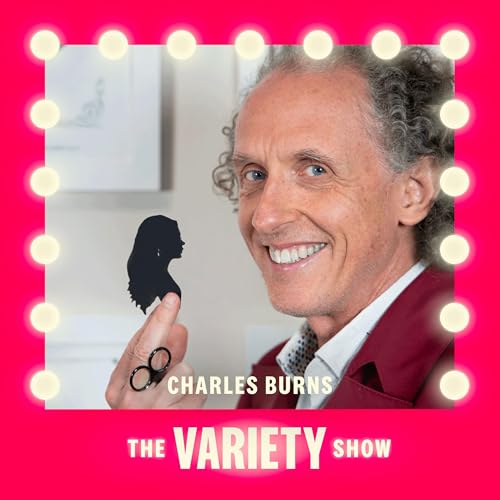
Charles Burns on royal silhouettes, Covent Garden origins, and the art of performing with scissors
カートのアイテムが多すぎます
カートに追加できませんでした。
ウィッシュリストに追加できませんでした。
ほしい物リストの削除に失敗しました。
ポッドキャストのフォローに失敗しました
ポッドキャストのフォロー解除に失敗しました
-
ナレーター:
-
著者:
このコンテンツについて
Join us on this captivating journey into the fascinating world of live entertainment. Host Adam Sternberg brings you engaging conversations with remarkable entertainers, from magicians and jugglers to aerial artists and contortionists. Discover the unique stories behind their extraordinary careers, the challenges they've faced, and the motivations that drive them. If you're passionate about live entertainment or simply curious about the lives of these extraordinary performers, this podcast is a must-listen.
Episode Highlights
In this episode, Adam welcomes silhouette artist Charles Burns a performer–artist whose entire show fits into a pocket: paper and scissors. From a bruising boarding-school experience to art college and the Covent Garden piazza, Charles charts how drawing led him to live silhouette cutting, why imperfection makes entertainment memorable, and what it felt like to interrupt Queen Elizabeth II (successfully!) to cut Her Majesty’s profile. He explains his mirror-free, one-line cutting technique, the psychology of likeness, why some people “don’t look like themselves” in profile, and how lockdown sparked his global Zoom silhouette studio. We also hear about AI silhouettes, Disney’s influence on the American style, and an 18th-century automaton “artist” with a human under the table.
Key Discussion Points
- Origins & Early Training: Growing up in Somerset; boarding at Ampleforth; bullying; sanctuary in the art room with sculptor-teacher John Bunting; discovering that drawing was the foundation.
- Art Education: Foundation at Exeter; time at the École des Beaux-Arts (Lyon); degree at Wolverhampton; art as communication vs. art-therapy.
- Artist vs Performer: Why most artists perform (and most performers create art); Charles sits “on the cusp,” literally performing portraits in front of an audience.
- Covent Garden Beginnings: Late-1980s street portraitist; a visiting Spanish cutter inspires the switch to silhouettes.
- Technique & Tools: Pocketed papers, white backing sheet, cutting largely in one continuous line; right-profile preference for a right-handed cutter; rotating the paper, not the scissors.
- Work & Temperament: “One of nature’s self-employed”; office life felt like returning to school politics.
- Neurodiversity: Son’s diagnosis led to Charles’s own autism-spectrum diagnosis in his 40s; reframing meticulous preparation as a strength.
- Everyone Can Draw: Fear often comes from bad early teaching; skill = motivation + hard work; drawing as the base of all visual art.
- Royal Encounter: Cutting Queen Elizabeth II at a Ritz Golden Jubilee party—nerves, etiquette, and simply stepping in; other high-profile sitters mentioned by Adam include Nelson Mandela and President Clinton.
- Capturing Likeness: Children who won’t sit still; poor lighting at events; self-image vs. profile reality; audiences often “rescue” a likeness because they see you as others do.
- Entertainment Over Perfection: Some silhouettes are better than others—human variability is part of the show; the joy of imperfection and the retelling (magicians’ lesson).
- Live Demonstration: Charles cuts Adam’s silhouette on-air—narrating chest→chin→nose→glasses→hair; occasional “back-cutting” fixes; speed builds with warm-up.
- Human vs. Machine: Low-tech authenticity matters; guests often expect equipment and are astonished it’s “just scissors.”
- AI & Automation: Experiments with AI-generated silhouettes; yes, a laser could cut them—but the human...



